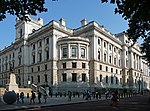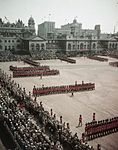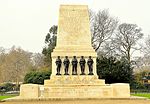Statue of the Earl Mountbatten, London
1983 establishments in the United Kingdom1983 in London1983 sculpturesMilitary memorials in LondonMonuments and memorials in London ... and 5 more
Outdoor sculptures in LondonPublic art in LondonSculptures of men in the United KingdomStatues in the City of WestminsterWhitehall

A bronze statue of Admiral of the Fleet Louis Mountbatten, 1st Earl Mountbatten of Burma is located on Mountbatten Green, off Horse Guards Road, Whitehall, London, England. The sculptor was Franta Belsky and the work was unveiled in 1983.
Excerpt from the Wikipedia article Statue of the Earl Mountbatten, London (License: CC BY-SA 3.0, Authors, Images).Statue of the Earl Mountbatten, London
Horse Guards Parade, City of Westminster Covent Garden
Geographical coordinates (GPS) Address External links Nearby Places Show on map
Geographical coordinates (GPS)
| Latitude | Longitude |
|---|---|
| N 51.503607 ° | E -0.12866 ° |
Address
Earl Mountbatten of Burma
Horse Guards Parade
SW1A 2AD City of Westminster, Covent Garden
England, United Kingdom
Open on Google Maps











